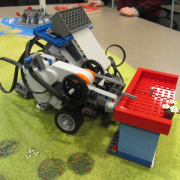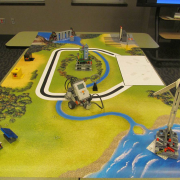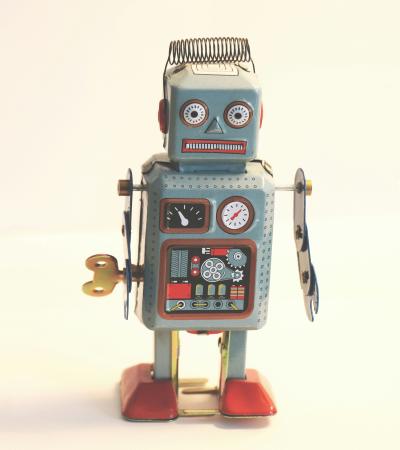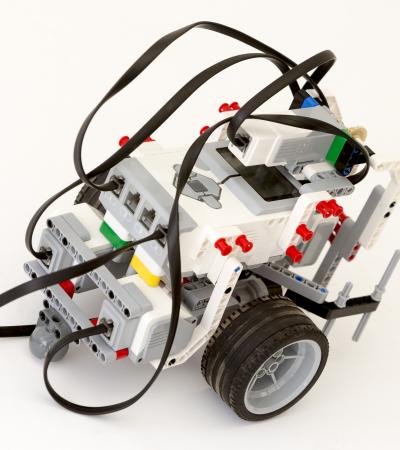Green City Robotics is a program in which students learn about sustainable living by building and programming Lego Mindstorm robots. The robots are programmed to complete challenges using Lego’s Green City Challenge set. The set includes practice mats, two Green City Challenge mats and 1,300 Lego bricks for building challenge models like wind turbines and power plants. Each week students complete a different challenge while learning about robots that assist with solar energy, recycling and other sustainable practices.
Advanced Planning
Each year the Evansville Vanderburgh Public Library (EVPL) offers robotics programs ranging from outreach classes to robotics clubs, summer camps and more. Projects are cumulative as students work toward designing robots to meet specific challenges. In the past, students have programmed Lego Mindstorms through a life-size maze and built catapults and cannons as part of a medieval challenge.
The Green City Robotics program has been offered as one of the projects for the robotics club. Students meet one day a week and work on their projects over the course of six weeks. The clubs rotate on a seasonal basis, with the exception of summer, when the library hosts its popular robotics camps.
The Green City Challenge set makes a great project for the club, since the students meet for six weeks and there are six challenges to complete on the Green City mat. Students must modify their robots each week to complete different challenges with the goal of completing them all by the end of the club.
Marketing
The primary marketing strategy that EVPL utilizes is programming calendars in print and online. Calendars are available for public viewing one month in advance of a particular program. Our printed calendars are separated into three groups: adult, teen and kids. Aside from our calendars, the library promotes events with social media and through our website.
Our robotics programs are one of the most highly anticipated events for students. In addition to the marketing discussed above, these programs generate popularity through word of mouth. Classes tend to have waiting lists and fill up quickly.
Budgeting
The Lego Mindstorms Green City Challenge set and activity pack were originally designed for use with the Lego Mindstorms Education NXT base set and software. This set was the original generation of Mindstorms, and the current generation is the Lego Mindstorms EV3. The Lego Mindstorms EV3 set costs $349.95. The EV3 programming software is available for free online at www.lego.com (Mac/PC), and there is also an education version of the software priced at $99.95. The EVPL owns Lego Mindstorms NXT 2.0 and EV3 sets. Students were able to modify the designs of the NXT 2.0 and EV3 robots to work with the Green City Challenge mat.
Lego sells the Green City Challenge set for $87.49. The accompanying activity pack is priced at $49.47 and contains instructions for building the Green City models. The activity pack also contains programming examples and instructions for robot designs.
The total cost of the program will depend on how many robotics kits your library purchases. In the past, students at EVPL have worked in pairs to complete challenges. Having students share a kit reduces the number of total sets needed for a class, while encouraging collaboration among students.
In addition, your library will need laptops so students can program their robots to complete the various challenges. The laptops can be shared among the students and should contain the programming software.
Day-of-event Activity
If time permits, students can build the wind turbine, power plant and other challenge models that comprise the Green City. However, be aware that many of the models take a good bit of time to complete. In the past, librarians at EVPL built the challenge models in preparation for the first program. Students were then able to concentrate on building and programming their robots for each challenge.
Prior to building with the Lego Mindstorm kits, quiz students on their knowledge of sustainable energy. For example, can students identify green energy practices in their own community? How many of them recycle their trash? Do students think there is a shortage of green spaces in the community? Many of these questions generated discussion about the Evansville community, including a future parks and recreation plan for the city.
Program Execution
In addition to building and programming the robots, it is important to introduce students to real-world examples. Students should be able to make connections between what they are building and how robots assist with sustainable living. During the course of the robotics club, librarians introduced students to real-world examples as the students completed different challenges each week. Many of these examples included videos accessible via YouTube.
For example, the video “Solar Robots Designed to Make Photovoltaics as Cheap as Fossil Fuels” discusses the use of solar robots in the installation and cleaning of solar panels. Students were shown this video as they completed the solar panel challenge on the Green City mat. This challenge involves a Lego Mindstorms robot installing a small solar panel on top of a miniature Lego house.
Other YouTube examples include “ABB Robotics - Painting Wind Turbine Rotor Blades” and “Robot Separates Recyclables from Other Garbage.” The former demonstrates how robots assist with painting blades on a wind turbine, whereas the latter demonstrates how they assist with sorting recycled materials from trash. At our library, these videos corresponded to the wind turbine, trash containers and trash loops challenges on the mat. All of these videos, and many more like them, introduce students to robots that assist with sustainable practices. It is important to provide these resources in order to enhance student learning and make connections outside the classroom.
Advice
Robotics have become one of the core technology programs available at many public libraries today. Robotics teaches students coding skills in addition to problem solving and engineering. While these programs have shaped the STEM (science, technology, engineering and math) activities available at public libraries, they often come at a high cost. Robotics sets can range anywhere from a couple hundred dollars to $1,000 or more. There is also the cost of the software and hardware needed to program the robots.
The best advice is to seek grants from organizations that may have an interest in STEM education. In the past, EVPL has received support for their robotics programs from Toyota Manufacturing of Indiana and Alcoa, Inc. Many of the skills learned in robotics classes are applicable to STEM careers common to these industries, such as automation, manufacturing and metals technology.
Lastly, seek support from auxiliary organizations such as your Public Library Friends or Public Library Foundation. The EVPL’s Public Library Foundation has supported robotics programs through additional funding for VEX robotics and Lego Mindstorm kits. The support of all these groups has been fundamental to the success of the library’s robotics programs.
*Images of EVPL’s robotics programs can be viewed at https://www.flickr.com/photos/evpl. Refer to the album titled “Youth Robotics at the EVPL.” All images are copyright of the library.
Supporting Materials
- Feedback (Coming Soon!)
- Programming Librarian Facebook Group





